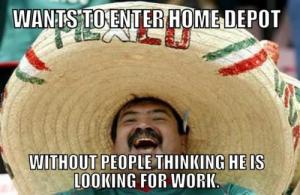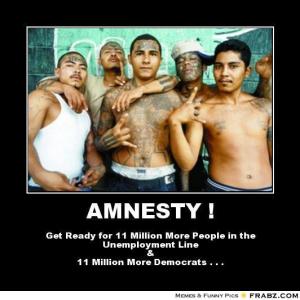- These images depict a stereotypical livelihood for Mexican and Latino-Americans. It shows them primarily as agricultural laborers who do simple labor for very cheap wages. They are often stereotyped as people who come to the United States only to work and to take jobs from Americans. By speaking about people in terms of their monetary value, we dehumanize them.


- Latino Americans (immigrants in particular) are shown as unwilling to assimilate into “American culture” and lazy for not learning English. They are often shown to be infiltrating of American society, morals, and language. Their culture is seen as subordinate and not something that we should want to be a part of as a nation.



- This image suggests that Latino immigrants will contribute to a dangerous, rough, gang culture. This shows them negatively and as not contributing members of society. It also assumes that they would all be liberal democrats. The first image also suggests that Latinos are not Republicans and will not agree with conservative ideology.


- This meme shows Latinos that just reproduce without warrant and have irresponsibly large families that they cannot adequately provide for. This stereotype again dehumanizes them and treats them more like animals that need to be controlled.

- This image plays off of a stereotype that Mexicans are gluttonous alcoholics.

- This image depicts an ongoing issue and debate about racial profiling in America. Some argue that it is inherently un-American to profile someone on the basis of race, and others deem it to be necessary. One of the most significant examples of this debate occurred in Arizona after a racial-profiling law was passed.


- The following article relates what Donald Trump, a leading contender for U.S. President recently said about the Mexican border and the action he would like to take in regards to illegal immigrants.
Donald Trump: ‘Great Wall’ on Mexican border — but not Canadian border
Business magnate and Republican presidential candidate Donald Trump arrives for jury duty in New York on Aug. 17, 2015. (Associated Press) more >
Exclusive Washington Times Daily Briefing (August 20, 2015)
Washington Times
By David Sherfinski – The Washington Times – Thursday, August 20, 2015
Republican presidential candidate Donald Trump joked Thursday that his U.S.-Mexico border wall will be known as “The Great Wall of Trump” while saying the country does not need a similar wall on the border between the United States and Canada.
“It’s something that can be absolutely done, not done at tremendous cost,” Mr. Trump said on Fox Business Network’s “Mornings with Maria.” “You know, it’s been costed by politicians and they came out with these outrageous numbers. As you know, I know how to build. I know how to get it done. We’ll have a great wall. We’ll call it the Great Wall of Trump. We’ll have a great wall and it’ll be — it’ll be actually — it can be a good-looking wall, as walls go, but we will have a really terrific wall and it’ll be done for the right price.”
Asked later by host Maria Bartiromo if Mr. Trump will indeed put his name on it, he replied: “No, I’m only — I’m only being facetious.”
He had brought up the Great Wall of China as a point of comparison and said there didn’t need to be a similar wall on the United States’ northern border.
“We don’t need a wall there. It’s a much different situation. And frankly in terms of Canada … you look at what’s going on with Canada, it’s a much different kind of situation that we have with Canada,” he said. “We have to police it; we have to be very vigilant; we have to be careful. But also the length, you’re talking about a tremendous length, a tremendous distance.”
“You know, interestingly, the wall on the southern border, it’s — really, if you think it’s a thousand miles. It’s 2,000 miles, but a lot of it — some of it’s done — it’s done poorly by the way, what they’ve done is very poor, very poor work, [a] very poor job, very — not much of a wall,” he said. “But you also have natural terrain which is automatically a barrier, which is a good thing. So you’re talking about a thousand. And then you look at the Great Wall of China that was built 2,500 years ago. It’s 13,000 miles. And we’re really talking about something … a little more than a thousand miles.
“You know, for years, they’ve wanted to do it,” he said. “I don’t know if you know, even Hillary Clinton, I mean, for years they’ve wanted to do it, but they could never get it figured out how to get it done. And, you know, one of the things that stopped it was the environmental impact statement. Can you believe it?”
“They couldn’t get an environmental impact statement completed to get the wall built,” he said. “That’s a whole ‘nother conversation.”
- The following article depicts how many Americans perceive immigrants as a problem in the United States.
AUGUST 24, 2015
What Americans want to do about illegal immigration
BY SARA KEHAULANI GOO168 COMMENTS

The debate over the future of the nation’s estimated 11.3 million unauthorized immigrantsis on the political front burner once more.
President Barack Obama set the stage in November when he announced new executive actions (now tied up in court) to prevent the deportation of millions of unauthorized immigrants, expanding 2012’s original program aimed mostly at providing relief to those brought to the United States as children. Illegal immigration has dominated the Republican presidential campaign, particularly after Donald Trump’s call for deporting all undocumented immigrants in the U.S. and building a wall along the U.S.-Mexico border. Others have called for a changing the constitutional amendment that guarantees birthright citizenship.
Among the public overall, there is little support for an effort to deport all those in the U.S. illegally, but surveys in past years have found greater support for building a barrier along the Mexican border and for changing the Constitution to ban birthright citizenship.
Republicans have long been conflicted over U.S. immigration policy. On the one hand, consistent majorities of Republicans favor providing a path to legal status for people in the U.S. illegally. Yet most Republicans also worry that granting legal status to undocumented immigrants would amount to a tacit reward for illegal behavior. And in the past, nearly half of Republicans supported changing the Constitution to bar birthright citizenship, and a majority supported building a fence along the entire U.S. border with Mexico.
Here’s a breakdown of public opinion on some key immigration issues:
Stay or deport? In a Pew Research Center survey conducted in May, a solid majority (72%) of Americans – including 80% of Democrats, 76% of independents and 56% of Republicans – say undocumented immigrants currently living in the U.S.should be allowed to stay in this country legally if they meet certain requirements. Last year, we asked a follow-up question of those who opposed granting legal status to undocumented immigrants: Should there be a “national law enforcement effort to deport” all immigrants here illegally? Just 17% of the public overall favored such an effort, including about a quarter (27%) of Republicans.
Moreover, in a 2013 survey, 76% of Republicans said that deporting all immigrants in the U.S. illegally was “unrealistic.”
One measure of public sentiment is how Americans have felt about the record number of deportations of unauthorized immigrants during the Obama administration – and an early-2014 survey found the public was divided. Overall, 45% of Americans called the increase in such deportations a good thing and the same share said it was a bad thing. Republicans (55% good thing), especially Republicans and Republican leaners who agree with the Tea Party (65%), were more likely than Democrats (37%) to have a positive view of increased deportations.
A majority (60%) of Hispanics saw the increase in deportations as a bad thing. In another survey of Latino adults in 2013, nearly half (46%) said they worry “a lot” or “some” that they, a family member or a close friend could be deported. And 56% said it was more important for undocumented immigrants to be able to work and live in the U.S. without the threat of deportation than to obtain a pathway to citizenship, according to our 2014 poll.
Birthright citizenship: One of the proposals raised in the current Republican presidential campaign is whether to change the U.S. Constitution’s 14th Amendment, which states, “All persons born or naturalized in the United States, and subject to the jurisdiction thereof, are citizens of the United States and of the State wherein they reside.” On that issue, a majority of Americans (57%) in February 2011 said that the Constitution should remain as it is, allowing any child born in the U.S. full citizenship; 39% favored changing the Constitution to bar birthright citizenship. (Also, we found that 87% of Americans were aware of this birthright.)
At that time, the idea of ending birthright citizenship drew broad opposition among Hispanics (73%), young people (73% of those under 30) and Democrats (66%). However, Republicans were divided: 49% wanted to leave the Constitution as it is, while 47% favored a constitutional amendment to bar birthright citizenship.
In 2012, at least 4.5 million U.S.-born children lived with at least one unauthorized parent, according to our analysis. Some 4 million unauthorized immigrant adults lived with their U.S.-born children.
Build a wall, or a fence: Our most recent survey on this issue was in October 2011. At that time, 46% favored building a fence “along the entire border with Mexico,” while 47% were opposed. Republicans (62%) were far more likely than independents (44%) or Democrats (39%) to support the construction of a border fence.
Overall views of immigrants: Views about immigration policies are often shaped by views about immigrants themselves: Are immigrants generally a problem, taking jobs and services, or do they strengthen the country through hard work and talents?
In our May survey, about half of Americans (51%) say immigrants strengthen the country, while 41% view them as a burden. (These opinions have fluctuated over the years, but in the mid-1990s, majorities said immigrants to the U.S. were a burden.) However, Republicans (63%) are far more likely than Democrats (32%) to say immigrants are a burden. And the share of Republicans who regard immigrants as a burden jumped 15 percentage points, from 48% in March 2014.
Declining immigration: The latest immigration debate comes against a backdrop in which the number of unauthorized immigrants coming to the U.S. has leveled off. That number peaked in 2007, especially for those from Mexico.
As growth of this group has stalled, there has been a recent sharp rise in the median length of time that unauthorized immigrants have lived in the U.S. In 2013, unauthorized immigrant adults had been in the U.S. for a median time of nearly 13 years – meaning that half had been in the country at least that long, according to a preliminary estimate. A decade earlier, in 2003, the median for adults was less than eight years.
Despite the renewed focus on immigration, it’s worth keeping in mind that immigration has not ranked high in our annual poll on the issues Americans see as a top priority for the president and Congress. Even among Hispanics, immigration has not been a top priority; a 2014 survey found that Hispanics rated education (92%), jobs and the economy (91%), and health care (86%) as extremely or very important issues but fewer said the same about immigration (73%).
Analysis:
Each of these sources subtly or overtly contributes to a single-sided “story” of Latinos in the United States. They are often depicted as poor, uneducated, non-English-speaking, dangerous, lazy, blue-collar workers . A very unfortunate implication of these views is seeing Latinos as subordinate or inherently incapable and undesirable human beings. Images that show enormous families and groups of people and ideas that Mexicans can work for any pay and under any condition, can create an idea that suggests that these people are a resource, or even worse, that they are dispensable.
Political rhetoric about Latino-Americans seems to be largely centered on the issues of immigration, which also tend to dehumanize people and turn them into numbers, statistics, and determinants of the economy. The U.S. tends to depict Mexicans as “outsiders”, especially when they emphasize the border and argue that these immigrants negatively affect or even hurt the United States.
These stereotypes and their dangerous implications are something that all teachers should be aware of and should actively seek to reeducate students on. Students who learn and accept these debilitating images of Latinos will be more likely to treat them unkindly and to regard themselves as superiors. Doing so will harm both the Latin-American student and the other student. If teachers are aware of these dangers, he or she can more actively seek to equalize opportunities for all students. He or she must confront their own prejudices in this regard and do all that they can to elevate and encourage their Latino students who may face these obstacles. As well, of course, they can promote correct ideology and treatment of all students, and help to stop other students from mistreating the Latino students. In regards to the curriculum, teachers can make a difference in teaching correct concepts (history, in my case) that do not degrade Latin-Americans but help to showcase what has been unseen and un-praised through most of U.S. history.
Sources:
Memes: http://www.hispanicmeme.com/wp-content/uploads/2012/08/lvg-5.jpg
Articles: http://www.washingtontimes.com/multimedia/image/ap_561d13cadd7a5d247f0f6a7067008fabjpg/
http://www.pewresearch.org/fact-tank/2015/08/24/what-americans-want-to-do-about-illegal-immigration/